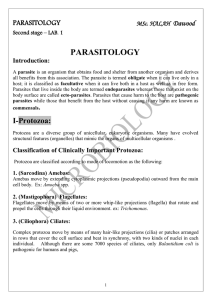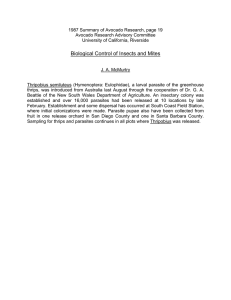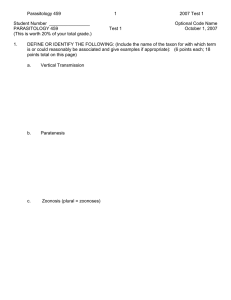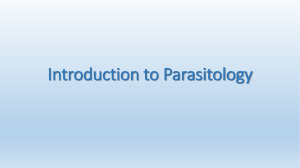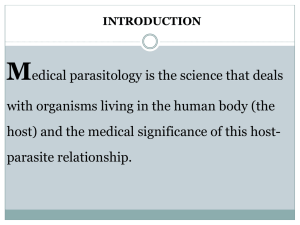Parasitology 1st lecture
advertisement
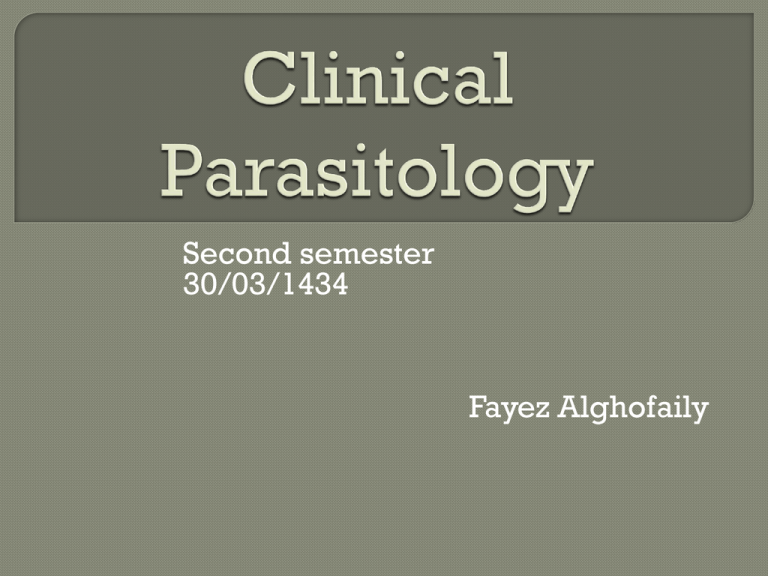
Second semester 30/03/1434 Fayez Alghofaily Clinical parasitology: study of important parasites which cause disease to human (classification, symptoms, disease, lifecycle, transmission, treatment). Microbiology= Virology, Bacteriology, Mycology and Parasitology Medical parasitology traditionally has included the study of three major groups of animals: parasitic protozoa, parasitic helminths (worms), and those arthropods that directly cause disease or act as vectors of various pathogens. More than 50,000 species have been described, most of which are free-living organisms. Protozoa are found in almost every possible habitat. A parasite is a pathogen that simultaneously injures and derives sustenance from its host. Some parasites are actually commensals, in that they neither benefit nor harm their host (Entamoeba coli). Parasites are organisms that obtain food and shelter by living on or within another organism. The parasite derives all benefits from association and the host may either not be harmed or may suffer the consequences of this association. Parasites are eukaryotic unicellular OR multicelluar. Don’t have cell wall. Infections of humans caused by parasites number in the billions and range from relatively harmless to fatal. The diseases caused by these parasites constitute major human health problems throughout the world. (For example, approximately 30% of the world's population is infected with Ascaris lumbricoides.) The incidence of many parasitic diseases (e.g., malaria) have increased rather than decreased in recent years. Other parasitic illnesses have increased in importance as a result of the AIDS epidemic. The migration of parasite-infected people, including refugees, from areas with high prevalence rates of parasitic infection also has added to the health problems of certain countries. The unicellular parasites are (protozoa) and multicellular parasites are (helminths, arthropods) Most parasitic protozoa in humans are less than 50 μm in size. The smallest (mainly intracellular forms) are 1 to 10 μm long, but Balantidium coli may measure 150 μm. The parasite is termed obligate when it can live only in association with a host or it is classified as facultative when it can live in or on a host as well as in a free form. Parasites which live inside the body are termed endoparasites whereas those which exist on the body surface are called ectoparasites. Parasites that cause harm to the host are pathogenic parasites while those that benefit from the host without causing it any harm are known as commensals. The organism that harbors the parasite and suffers a loss caused by the parasite is a host. The host in which the parasite lives its adult and sexual stage is the definitive host whereas the host in which a parasite lives as the larval and asexual stage is the intermediate host. Other hosts that harbor the parasite and thus ensure continuity of the parasite's life cycle and act as additional sources of human infection are known as reservoir hosts. An organism (usually an insect) that is responsible for transmitting the parasitic infection is known as the vector. Parasites: • Protozoa • Helminths • Arthropods Protozoa are unicellular parasites. 1. Sarcodina: motile by false feet ex. Entamebea histolitca 2. Mastigophora: motile by flagella ex. Giardia lambelia 3. Ciliophora : motile by cilia ex. Balantidium coli 4. Sporozoa: non motile ex plasmodium and toxoplasma gondii
